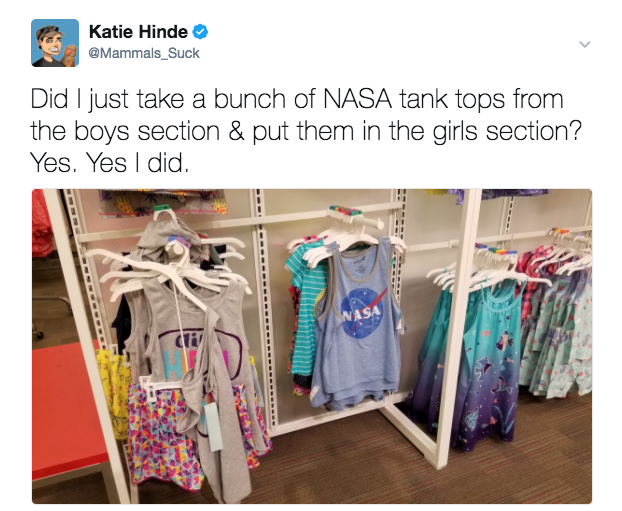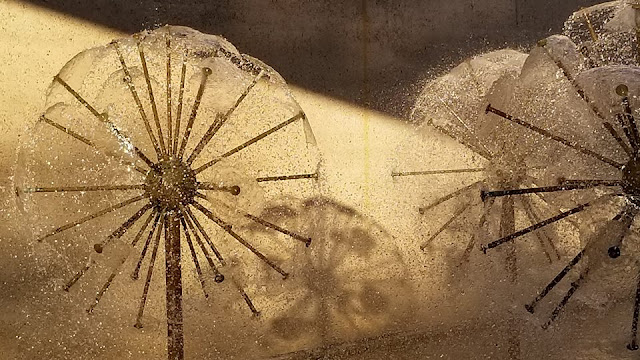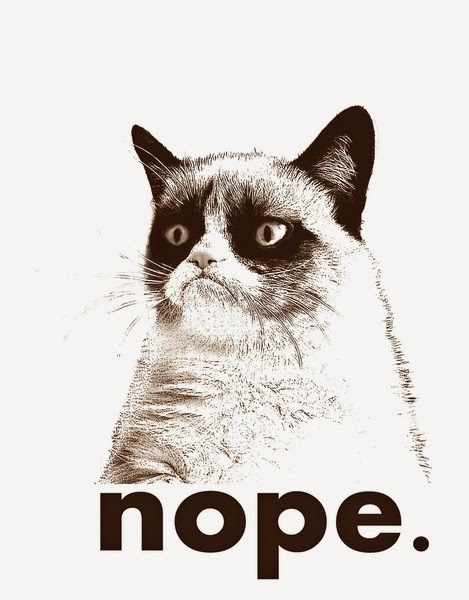Portrait of an Unexpected Twitter Storm
Woooo buddy, it’s been quite the 34 hours. Sunday night I was looking for super hero t-shirts in the “girls” section at a Big Box Store, not finding them, and then unwittingly jumped down a rabbit hole.
From the home, to the classroom, to the store, our culture reinforces limitations on children due to their sex/gender. As a scientist who works on inclusivity in academia and science, I spend a lot of time thinking about the pipeline. I am particularly concerned about the scarcity and disparity of science & science fiction oriented toys, clothes, and outreachfor girls. A situation that reinforces, and is reinforced by, widespread gender norms. Parents underestimate their daughters interest in science and think science is harder for them- despite no differences in daughter and son interest or performance. Female teachers anxious about their math ability affect the math abilities of their female students. And girls are more likely than are boys to think their teachers think they are bad at math. From childhood, to adolescence, to adulthood, women encounter different obstacles to achievement in science, technology, engineering, and mathematics. Across the world, lower national measures of gender-science stereotypes are associated with better representation of women in scientific careers.
And standing in that Big Box store aisle, surrounded by too much stereotypically gendered clothing, I had a George Banks is saying no moment. I took the NASA shirts from the “boys” section from where they were prominently displayed, and put them little kid eye level next to tank tops in the “girls” section 20 feet away. And shared a pic of my tiny-scale, subversive, nonviolent, direct action.
And then…
As of right now when I post this essay, there have been 115,111 hearts. 23,000+ RTs. & 3000 comments to my account on twitter. Cross-postings, links, writers, cultural critics, so many folks weighing in. So many people amplifying how meaningful it is to disrupt the ways in which we undermine our children through gender stereotyping.
Someday I hope to organize all the responses so I can calculate the proportion of tweets for each of the key themes that emerged. But until then & because of cognitive biases in the human mind, I spent much of today grappling with the responses that were critical of my tweet.
Some of these are *really* important. I RT’d key examples of them, they motivated me to do more information gathering, and have shaped how I will approach these actions moving forward (discussed at the very end).
Let's address these in turn:
“This is a non-issue bc they have NASA shirts for girls”
Yes, Target has NASA shirts for girls (awesome!). But I never indicated which Big Box Store I was in, bc I was making a broader social critique of gendered children’s clothing. But apparently, Target should do some serious back-patting on brand recognition with minimal visual clues. In between the backpatting for the sustained effort addressing these kinds of gendered shopping experiences. Once folks started talking about NASA shirts for girls there, I went back the next morning to find them and check on some other things. The NASA shirts in the “boys” sections were placed in three different locations (2/3 were prominently on the main aisles visible from 20+ feet away) and positioned at three different eye levels for typical heights in early childhood, middle childhood, and adulthood. For the girls' staff told me that they definitely had them in the store... somewhere. Turned out, the girls’ NASA shirts were in one location at the back of one section, facing a divider, away from the main path. Other folks have talked about how their local store has prominent NASA & science displays for girls. Sadly not so my store. Yet.
Having returned to the store, I did a more thorough exploration of the images & messages being marketed by gender. There were a lot of marine biology shirts in the girls’ section (yay!). On the other hand, lots of examples of gender stereotyping during toddlerhood: t-shirts for little girls telling them to smile, be kind every day, how to share, and that they can be anything they want (especially if it involves smiling, kindness, and sharing, eh?).
Toddler boys’ clothes mostly emphasized other traits.
Throughout these sections are posters and mannequins showing boys and girls in the clothing of their “respective” sections. Moreover, in the posters the little boys are very active while the girls are more typically stationary posing.
Many folks tweeting in response to my moving merchandise said “Just take daughters to the boys section to pick out clothes, nbd.” Except that by 18-24 months of age, kids are already sensitive to gender stereotyping that continues strongly throughout childhood. This means many girls will perceive that the “boy” clothes and the themes featured there, are not for themselves. But even for the girls who love transcending arbitrary stereotyping sections, there remains an issue. Because it is a two way street, clothing section differences reinforce gender stereotypes among boys. Stereotypes about their own interests and about girls’ interests. Similar things happen with toys.
There are more & more platforms and programs to increase girls interest and access to STEM, often involving women scientists as role models, mentors, and guides. But in so many ways it is important for boys to see and interact with women scientists, for them to spend time with girls as capable science enthusiasts. Otherwise women are more likely to experience gendered stereotypes in college, grad school, and later in their careers. And this isn’t just about gender. Inclusive interactions are essential across diverse identities along dimensions of race, faith, ethnicity, gender, sexuality, health, dis/ability, age.
“You should have done something different”
Yes, change happens many ways, in response to many tactics, deployed by many people with different skill sets, personalities, and approaches. But there is no one way. Some folks suggested that instead of disrupting merchandise it’s better or has more impact to write letters, make phone calls, leave comment cards rather than engage in direct action. Some suggested that these were better steps to take because moving merchandise impacts low wage employees but doesn’t get communicated to those who hire and fire (and incidentally can’t join the Wobblies).
But my phone calls don’t go to the CEO, my letters aren’t opened and read by the head of merchandising, the person who took my comment card wasn’t a major stakeholder- these tactics first reach lower-level employees within the corporate structure. And phone calls, letters, and comments cards aren’t visible at little kid eye level in the clothing section. And all of this is siloed within a particular company. The conversation is bigger than any one company. Seriously, the next time you are in one of these kinds of stores look around and think about how they set children on particular trajectories… and whether those trajectories are equal in prestige, income, and opportunity.
Thinking about tactics more broadly, occupying and marching that shuts down traffic disproportionately impacts shift workers on exact schedules- but such tactics can influencelong-term gains. Modern organized boycotts typically risk brand reputation, influencing shareholder’s to pressure leadership before profits are too impacted, but when profits are impacted, folks get laid off. Shop-ins, penny exchanges, warning labels, repositioning merchandise, placing politician autobiographies in bookstore crime sections- these are all tactics that have been employed since the mid-1900s in stores & businesses to shape public perspective, consumer choices, and corporate approaches.
“That is some white feminist BS”
The most important critiques are the comments faulting the tweet for being unanchored to intersectional feminism. This construct was initially established to address the combined impact of simultaneously experiencing both sexism and racism of Black women in the US. For the many white women who amplified my tweet and are planning their own disruptive campaigns, please consider how white women feminists historically& contemporarilycenter white women’s issues within feminism. Anyone who visited threads in Pantsuit Nation or the March for Women encountered numerous examples of white feminism stubbornly disinclined to recognize or work to dismantle disparities or to include and prioritize diverse women within the central platform. Across faith, race, dis/ability, ethnicity, LBTQQIA, and poverty, addressing disparities of the lived experiences among women at intersections is too often delayed, disdained, and derailed by many white feminists. So when PoC confront something- like me making extra work for low-wage workers- I pay attention. Because it matters.
Please read the linked essays above because those voices are much more knowledgable than mine. I think, there are several elements of white feminism here (probably even more). My move to increase science as binned with girls is anchored around an agenda of equality whereas the intersectional agenda more frequently centered in Black feminism is likely an agenda of justice. Justice in kids being able to safely walk home or to the park without being shot by police or citizens. The dialogue around #SayHerName #BlackLivesMatter #ICantBreathe and more and more and more. Disrupting the "more prominent marketing of science clothing in boys section" has much lower stakes. So the combination of a white woman, seemingly impacting low-income workers (who are more likely to be women and in many states more likely to be WoC) for a performative bit of low stakes issue is pretty classic white feminism.
Thank you to the PoC, especially BW, who generously took time yesterday to address the importance of intersectionality in response to my tweet.
Please read the linked essays above because those voices are much more knowledgable than mine. I think, there are several elements of white feminism here (probably even more). My move to increase science as binned with girls is anchored around an agenda of equality whereas the intersectional agenda more frequently centered in Black feminism is likely an agenda of justice. Justice in kids being able to safely walk home or to the park without being shot by police or citizens. The dialogue around #SayHerName #BlackLivesMatter #ICantBreathe and more and more and more. Disrupting the "more prominent marketing of science clothing in boys section" has much lower stakes. So the combination of a white woman, seemingly impacting low-income workers (who are more likely to be women and in many states more likely to be WoC) for a performative bit of low stakes issue is pretty classic white feminism.
Thank you to the PoC, especially BW, who generously took time yesterday to address the importance of intersectionality in response to my tweet.
And to quickly address some of the other issues raised:
-Yes, I worked in retail for nearly a decade. Yes, I did merchandise display, customer service, and restocking. Yes, I have worked jobs at minimum wage and jobs below minimum wage.
-Yes men and women typically have differently shaped and proportioned bodies so clothing tailored by gender is typically sought by consumers… but the topic at hand is children’s clothing sections. And under 10, kids proportions and shapes are typically much more similar than are adults.
-No I didn’t move any clothes that created any confusion about price. There were no prices on racks, only prices attached to the garments moved and the garments adjacent.
-There was debate among tweeters in retail about the magnitude of the impact on workers of moving these shirts to the girls’ section- how late folks would have to stay, time spent away from their family, the risk to their employment, or employee reviews. For what it’s worth, when I got to the store on Monday morning there were no negative consequences for staff as a result of my actions on Sunday. The t-shirts were where I had put them (so no one stayed late to move them) and the inventory person had just arrived a shelf away. We chatted about my action, my tweet, and the merch set up. Her perspective on it differed from many of the folks commenting on twitter, but clearly no one person’s perspective is universal.
-Every few years I manage to touch the 3rd rail of the internet and I am reminded how aggressively histrionic so many men can be toward women disrupting the status quo. Since this tweet I have been called repeatedly <offensive terms warning> "idiot", "ass", "whore", "piece of shit", "dick", "moron", "twat", "bitch", "crazy bitch", "asshole", "motherfucker", "garbage", "cancer", "psychopath", "faggot", "dyke", "dyke ass", "cunt", and "retard". I’ve been told to "shut up" and "fuck off". I was told I should be "punched in the head", "raped", "euthanized", that I "needed a bullet to the brain", and "should kill myself". I was sent cartoons of Nazis kicking women on the ground.
Because I moved 5 shirts.
25 feet.
And many times while they were cursing at me, they included the assertion that what I was doing was useless, didn't matter, and was totally insignificant.
These men are sure worked up for something they say is so insignificant.
What now?
And after sitting with all of this today- the accolades and the ire- I think tiny-scale, subversive, nonviolent, direct action of moving merchandise around to disrupt gender stereotypes is possible without creating more work or trouble for retail workers. I can look for clothing items off their hanger, off their rack, discarded on the ground, and fix them. As many items as the number of items I want to move to push back on gender stereotyping. Already did 5 for the 5 shirts I moved. This makes my actions “work load neutral” for the person working in that section, that shift. I will then return the next day to submit a comment card describing what I did so that the customer is held accountable for the movement of the merchandise, not the staff. Then there is paperwork that may make it the headquarters, and science t-shirts at little girl eye level.
Other Merchandise Protests & Reducing Childhood Gender Stereotypes
Related Blog Readings:
Work in Progress: Changing Academic CultureBench to Bedside: Breastfeeding Best Practices Embrace Social Science
Got Bias? Adventures in Academic Publishing
Touchstones & Cornerstones










Comments
Post a Comment